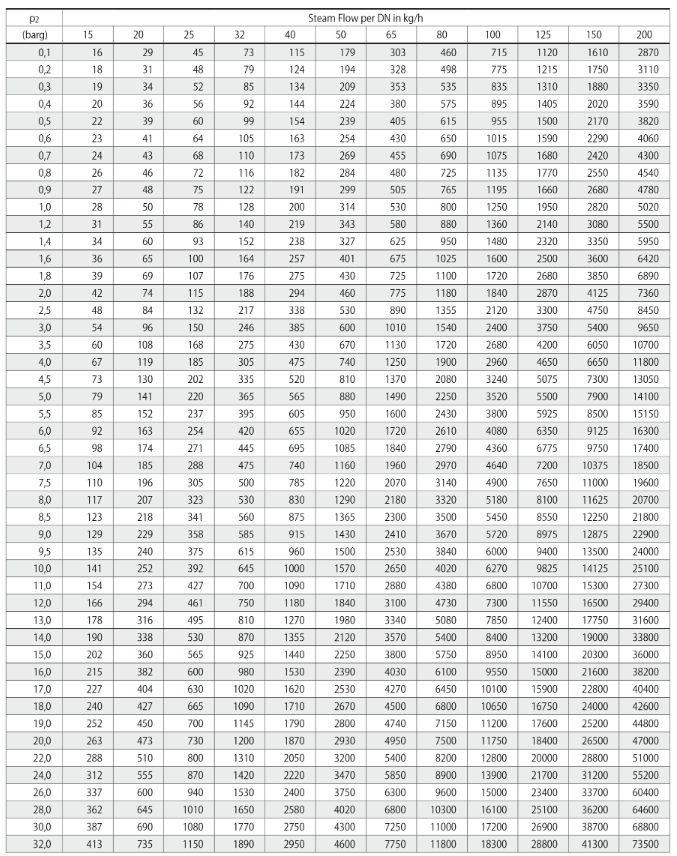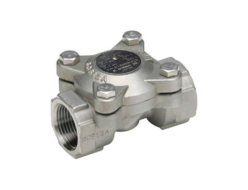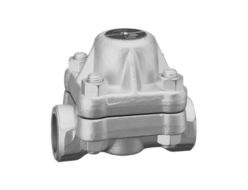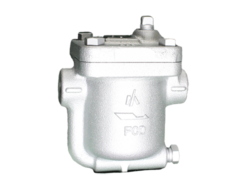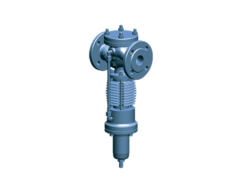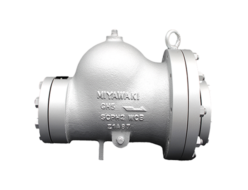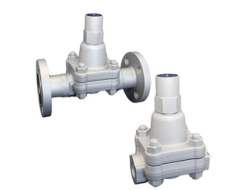Miyawaki
Miyawaki RE20 Direct Acting For Steam

Manufacturer: MIYAWAKI Inc.
Model: RE20
Features
Self-acting pressure reducing valve for steam
This valve reduces the steam supply pressure to a defined outlet pressure and keeps it steady, even under downstream fluctuations . The valves needs no seperate energy source.
Operating features of direct acting pressure reducing valves
Pressure changes on the downstream side are detected in the detection chamber, and the degree of opening of the valve is directly adjusted to keep the pressure on the downstream side at set pressure.
Wide range of pressure reduction
Due to carfefully selected springs an outstanding reduction ratio of 25:1 is achieved.
Diaphram free design
The valve operates with an O-ring sealing and a piston design. Due to this design, no daiphragm and no external sensing line is required.
Superb durability
Highly durable and carefully selected components, a 360° free rotating, conical plug and the lack of a sensitive diaphragm ensure outstanding lifetime of this valve.
Options available
– additional pressure gauges
– tailored connections for special applications
– softsealing for leakage class VI
Typical applications
Perfect for all applications with medium to high steam flow or high reduction. In particuliar power plants, chemical and petrochemical process applications, ships, food and beverage plants, and other similar installations of of compact steam equipment.
Dimensions/Weight

Size | Dimensions (mm) | Kvs Value | Weight | ||
| L | H | h | |||
| 15 | 130 | 410 | 82 | 1,8 | 11,4 |
| 20 | 150 | 66 | 3,2 | 11,4 | |
| 25 | 160 | 66 | 5,0 | 12,5 | |
| 32 | 180 | 81 | 7,9 | 14,5 | |
| 40 | 200 | 83 | 13,0 | 16,0 | |
| 50 | 230 | 586 | 100 | 20,0 | 35,0 |
| 65 | 290 | 615 | 113 | 34,0 | 39,5 |
| 80 | 310 | 733 | 140 | 51,0 | 52,5 |
| 100 | 350 | 762 | 154 | 80,0 | 68,0 |
| 125 | 400 | 715 | 210 | 130,0 | 150,0 |
| 150 | 480 | 720 | 235 | 180,0 | 180,0 |
| 200 | 600 | 950 | 285 | 320,0 | 330,0 |
Specifications
| PN16 | |
| Max. design pressure (MPa) PMA | 1,6 |
| Max. design temperature (℃) TMA | 350 |
| Max. operating pressure (MPa) PMO | 1,5 |
| Max. operating temperature (℃) TMO | 350 |
| PN | Temperature ℃ | ||||||
| -10・・・+50 | 100 | 150 | 200 | 250 | 300 | 350 | |
| Pressure MPa | |||||||
| PN16 | 1,6 | 1,6 | 1,6 | 1,5 | 1,4 | 1,3 | 1,1 |
| PN25 | 2,5 | 2,5 | 2,4 | 2,3 | 2,2 | 2,0 | 1,8 |
Secondary pressure range | DN15-DN40 | DN50 | DN65 | DN80 | DN100 | DN125-DN200 |
| MPa | Spring number per size | |||||
| 0,05-0,1 | 9 | 28 | 27 | 38 | 37 | On request |
| 0,1-0,16 | 8 | 27 | 26 | 37 | 36 | |
| 0,16-0,25 | 7 | 26 | 25 | 36 | 35 | |
| 0,25-0,4 | 6 | 25 | 24 | 35 | 34 | |
| 0,4-0,63 | 5 | 24 | 23 | 34 | 33 | |
| 0,63-1,0 | 4 | 23 | 22 | 33 | 32 | |
| 1,0-1,6 | 3 | 22 | 21 | 32 | 32 | |
Secondary pressure higher than 1,6 MPa on request
A minimum differential pressure of 0,05 MPa is required.
Steam Flow Rate
Tables of calculation for steam
RE20 (REH20, REC20) RE2OL (REH20L, REC20L)
How to select the size of a PRV correctly?
Check the operating data:
- Inlet pressure p1
- Requested downstream pressure p2
- Requested steam flow
Check the requested steam flow in the capacity chart on page 15. Select the necessary size of the PRV. The table 1 shows the maximum available steam flow in kg/h at a given inlet pressure. If the ratio between the requested downstream pressure p2 and the inlet pressure p1 is lower than 0.577 (critical flow), pay attention that the steam pressure is shown as bar abs!


If the ratio between the downstream pressure p2 and the inlet pressure p1 is larger than 0.577 (non-critical flow), the available steam flow amount on the downstream side will be reduced. To get the maximum available downstream flow amount, the maximum steam flow from Table 1 must be multiplied with the calculation factor A. To get the Factor A, see Diagram 1.
Now check whether the requested steam flow will be available on the downstream side. The capacity chart (Table 2) on page 16 shows the maximum steam flow on the downstream side in kg/h considering a steam velocity not higher than 40 m/s. Pay attention that the steam pressure is shown in bars. Select the corresponding size. If the size of the steam piping on the downstream side will be 1–2 sizes larger than the inlet size of the PRV, the selection of the inlet size will be correct. But, if the difference between the inlet size found in Table 1 at page 15 and the downstream size in Table 2 at page 16 will be larger than 2 sizes, the inlet size of the PRV must be increased. The difference between the inlet size and the pipe size at the downstream side should not be larger than 2 sizes.
Example of calculation:
Operating data:
- p1 = 9 barg = 10 bar abs
- p2 = 6 barg = 7 bar abs
- Steam flow G = 1,100 kg/h
Search for the necessary size of the PRV in accordance with p1:

Table 1 shows 1,312 kg/h for size DN40 (1½”).
p2 / p1 = 0.7 (i.e., larger than 0.577)
Factor A acc. to Diagram 1 = 0.96
Max. available steam flow G = 1,312 kg/h x 0.96 = 1,259 kg/h
Steam flow in accordance with Table 2 at 6 barg = 1,720 kg/h for DN65.
Conclusion: The PRV with an inlet size of DN40 and an increase of the pipe size to DN65 at the downstream side will be suitable for a flow amount of 1,100 kg/h at the given pressures.
Capacity Chart
The Table 1 shows the maximum available steam flow amount of the pressure reducing valve at a given inlet pressure, if the ratio between the downstream pressure p2 and the inlet pressure p1 is lower than 0.577 (critical flow). Pay attention that the inlet steam pressure p1 is shown as bar abs.
![]()
TABLE 1
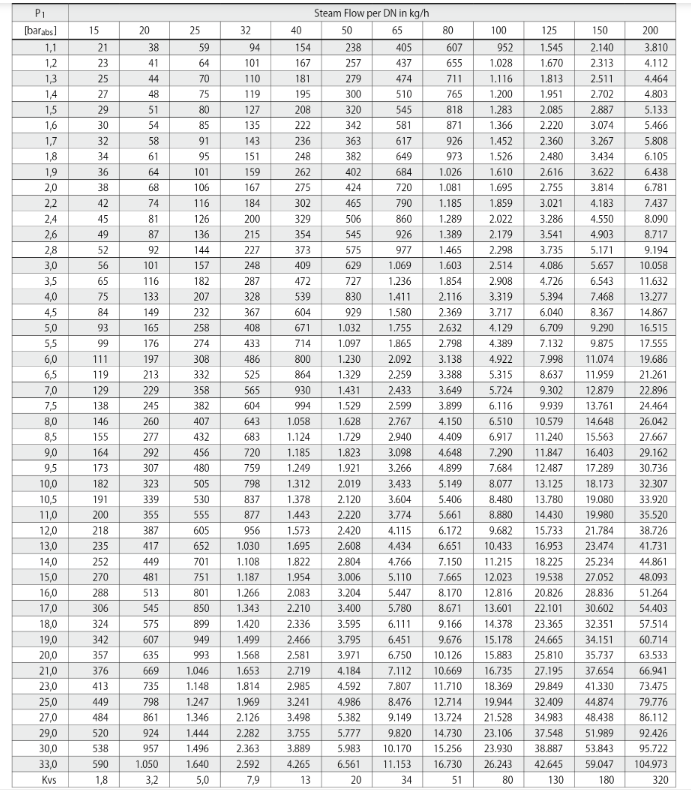
![]()
Capacity Chart
The Table 2 shows the maximum available downstream steam flow amount of the pressure reducing valve at the requested downstream pressure p2. Pay attention that the steam pressure p2 is shown as barg.
TABLE 2
